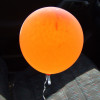Earth's day and night cycle
Interview with
It’s that time of year when many of us in the northern hemisphere prepare to scurry around our homes setting our non-digital clocks back one hour to reflect the end of daylight saving time…and the arrival of winter. Changing the clocks in this way, as we’ll find out a bit later, is a relatively new phenomenon and one that is dictated by national governments. Night and day, however, is a consequence of the Earth’s tilt on its axis. But how exactly does it work? Chris Smith popped along to visit Dr Matt Bothwell, public astronomer at the University of Cambridge’s Institute of Astronomy...
Matt - Our planet is spinning. We spin once every 24 hours, the sun shines on one side of the planet and that gets daytime, the night side of the planet on the other side from the sun is night time. And then, every 24 hours, the earth rotates and we swap places.
Chris - So if you are in a big country and you are over on the East side of that country, the sun is rising for you earlier than people on the other side of that country?
Matt - Exactly, yeah. If you imagine being in New York or something on the East coast of America, you are going to spin around onto the daylight side of the planet and the people in New York will see sunrise even when people in California are still firmly in the nighttime side of the planet.
Chris - What about going up and down the planet? If you are on the equator, how does the time the sun rises and sets differ compared with, say, if you're up in London?
Matt - So that gets a bit more complicated, and it depends on the time of year. It's all down to this fact that the earth is a bit wonky. If the Earth was a perfectly sensible planet, straight up in our solar system, there would be no variation. Days and nights would have equal lengths at all times of year on all parts of the planet. But the earth is wonky: it's knocked on its side by this angle of about 23 degrees, which gives us all kinds of interesting effects, one of which is the different day and night times as you go up and down the planet. So, in summertime, the days are longer and in winter the days are shorter.
Chris - What does that do to the timing of sunrise and why does the tilt of the planet affect that timing?
Matt - So, in summertime, which is when we are tilted towards the sun, the sun rises earlier and earlier. I think the easiest way to think about it is, if you just imagine a sphere on its side, a bit wonky, being illuminated by light from the side that's tilting towards the light, well there is more of the light on that side of the planet. And so you spin round and you'll hit that light side just a little bit earlier than you would otherwise.
Chris - And the same's going to go for the setting of the sun, so it's going to set earlier as well. And that means you're going to get a shorter day in winter and a longer day during the summer?
Matt - Yes, exactly. In the summer, that light patch is bigger, and so sunrise is earlier and sunset is later. And then, in the winter, you have the complete opposite effect, there's much less of the illumination. So the sunrise is later and sunset is earlier. And then we have those horrible short days in the winter where the sun never rises and then when you leave work at 5:00 PM it's nice and dark.
Chris - What about the extreme, which is when you go into the far North or the far South and there is this phenomenon of the land of the midnight sun.
Matt - So, at the very extreme, so either the North Pole or the South Pole, let's imagine the North Pole, for example. In summertime, the North Pole is tilted towards the sun and because of the Earth's tilt, during one entire rotation, you stay entirely within the illuminated bit. So the sun never goes below the horizon. So yes, in the summertime in the North it is the land of the midnight sun where you will just look up and see the sun doing a little circle around the sky and never actually dipping below the horizon. And the opposite is true in the winter. I'm part of the South Pole telescope collaboration. I've never actually been down to the South Pole, but my collaborators go down for the winter and you see the last sunset in the winter and then you are in for about four months of darkness until you see the sunrise again.
Chris - I'd never thought about it from the perspective of an astronomer. And so this is the time to go or at least the time to observe because you've got uninterrupted 24/7 viewing.
Matt - Absolutely, yeah. The South Pole in the winter is one of the best places on earth to observe the sky. There are lots of cosmological and astronomical experiments down at the South Pole because it's astonishingly dark and dry for months at a time.
Chris - I know what I think about the answer to the next question, but I'm going to ask you: it's that time of year again, clock change time. Some people are manoeuvring to stay in one time zone all the time. Are you a fan of changing the clocks or would you prefer to be on one time all the time? And what time would you choose?
Matt - So I think I can answer this with two different hats on: my personal and professional. And they're both the same answer. So, personally, I quite like the clock change. I think there's something quite cosy about wintertime and it getting a bit dark earlier.
Chris - You like that extra hour in bed, don't you, in winter?
Matt - That might be part of it. But also, professionally, from an astronomical star gazing point of view, having the early nights in winter means more hours of darkness to see the beautiful night sky.





Comments
Add a comment